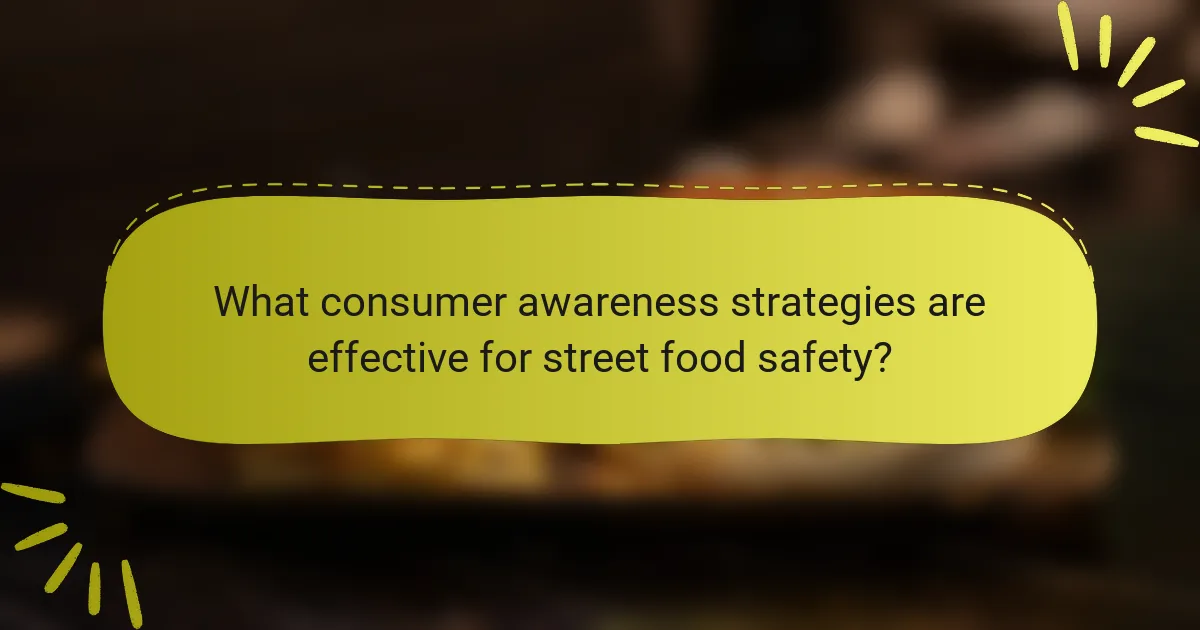Street food restaurant safety encompasses critical aspects such as proper food handling, hygiene practices, and adherence to regulatory standards. Key practices include frequent handwashing, glove usage, regular sanitization of surfaces and equipment, and safe food storage temperatures to prevent spoilage and contamination. Compliance with local health codes and obtaining necessary permits are essential for street food vendors, alongside regular inspections by health authorities. Consumer awareness initiatives, including education campaigns and clear labeling, play a vital role in promoting safe food handling and reducing the risk of foodborne illnesses. Engaging the community and informing consumers about safety practices fosters trust and encourages informed choices regarding street food options.

What are the key aspects of street food restaurant safety?
Key aspects of street food restaurant safety include proper food handling, hygiene practices, and compliance with regulations. Food handlers must wash their hands frequently and use gloves when necessary. Equipment and surfaces must be sanitized regularly to prevent contamination. Food should be stored at safe temperatures to avoid spoilage. Additionally, street food vendors must adhere to local health codes and obtain necessary permits. Regular inspections by health authorities help ensure compliance. Consumer awareness about food safety practices also plays a crucial role in preventing foodborne illnesses.
Why is hygiene critical in street food restaurants?
Hygiene is critical in street food restaurants to prevent foodborne illnesses. Poor hygiene practices can lead to contamination of food, which poses health risks to consumers. According to the World Health Organization, foodborne diseases affect millions globally each year. Cleanliness in food preparation areas reduces the likelihood of harmful bacteria spreading. Regular handwashing and proper food storage are essential hygiene practices. Ensuring staff follow hygiene protocols protects public health. Street food vendors must comply with local health regulations to maintain safety standards. Overall, hygiene is vital for consumer trust and business sustainability.
What are the common hygiene practices in street food establishments?
Common hygiene practices in street food establishments include regular handwashing, proper food storage, and equipment sanitation. Street food vendors must wash hands frequently, especially after handling raw ingredients. They should store food at safe temperatures to prevent bacterial growth. Additionally, surfaces and utensils must be sanitized regularly. Vendors should use clean water for cooking and washing. Proper waste disposal is essential to avoid contamination. Adhering to local health regulations ensures compliance and safety. These practices help minimize foodborne illnesses among consumers.
How do hygiene practices impact consumer health?
Hygiene practices significantly impact consumer health by reducing the risk of foodborne illnesses. Proper handwashing, food storage, and sanitation protocols prevent contamination. According to the CDC, foodborne diseases affect 48 million Americans annually. Effective hygiene can lower these statistics by ensuring safe food handling. Clean environments also promote consumer confidence in food establishments. This confidence can lead to increased patronage and economic benefits for restaurants. Studies show that consumers are more likely to choose establishments with visible hygiene practices. Therefore, maintaining high hygiene standards is crucial for consumer health and business success.
What regulatory standards govern street food safety?
Regulatory standards governing street food safety vary by country and region. These standards typically include food safety regulations, health codes, and licensing requirements. In many places, street food vendors must comply with local health department guidelines. These guidelines often cover food handling, storage temperatures, and sanitation practices. For instance, the U.S. Food and Drug Administration (FDA) provides model food codes that many states adopt. Compliance with these codes ensures that food is safe for consumption. Additionally, some countries have specific regulations for mobile food units. These regulations may require regular inspections to maintain safety standards.
Which organizations set these regulatory standards?
The organizations that set regulatory standards for street food restaurant safety include the Food and Drug Administration (FDA) and the World Health Organization (WHO). The FDA provides guidelines for food safety and hygiene practices in the United States. The WHO offers international standards and recommendations to ensure food safety globally. Additionally, local health departments enforce regulations specific to their regions. These organizations collaborate to promote safe food handling and public health.
How are these standards enforced in street food restaurants?
Standards in street food restaurants are enforced through regular inspections by health authorities. These inspections assess compliance with hygiene and food safety regulations. Violations can lead to fines, penalties, or closure of the establishment. Training programs for food handlers are also mandated. These programs educate staff on safe food handling practices. Additionally, public health campaigns raise consumer awareness about food safety. Consumer reports and feedback can influence enforcement actions. Local governments often provide resources to support compliance among street food vendors.
How can consumers ensure their safety when eating street food?
Consumers can ensure their safety when eating street food by following specific guidelines. First, they should choose vendors that display cleanliness and hygiene. Observing the food preparation area for cleanliness is crucial. Consumers should also check if the vendor uses gloves and proper utensils. Freshly cooked food is safer than food that has been sitting out. It is advisable to avoid raw or undercooked dishes. Additionally, consumers can ask about the source of ingredients. Vendors who can provide information about their suppliers demonstrate transparency. Lastly, checking for local health department ratings can provide assurance of safety standards. These practices reduce the risk of foodborne illnesses associated with street food.
What signs indicate a safe street food vendor?
A safe street food vendor shows several clear signs. First, the vendor maintains cleanliness in their food preparation area. This includes visible sanitation practices such as handwashing and clean utensils. Second, food is kept at safe temperatures to prevent spoilage. Hot foods should be hot, and cold foods should be cold. Third, the vendor displays necessary permits and licenses. These documents indicate compliance with local health regulations. Fourth, food is prepared in front of customers. This transparency builds trust and allows for observation of hygiene practices. Lastly, the vendor uses fresh ingredients. Freshness is crucial for food safety and quality. These signs collectively indicate a commitment to food safety.
How can consumers report unsafe practices in street food establishments?
Consumers can report unsafe practices in street food establishments by contacting local health departments. They should provide specific details about the unsafe practices observed. This can include issues like food handling, cleanliness, or pest infestations. Many health departments have hotlines or online forms for such reports. Reporting helps ensure public safety and can lead to inspections. Local health authorities have the responsibility to investigate complaints. They often publish guidelines on how to report unsafe practices. This process is crucial for maintaining food safety standards in the community.

What are the specific hygiene practices for street food vendors?
Street food vendors must adhere to specific hygiene practices to ensure food safety. They should regularly wash hands with soap and water, especially before food handling. Vendors must use gloves when preparing food to prevent contamination. Clean utensils and cooking equipment are essential; they should be sanitized frequently. Food should be stored at proper temperatures to inhibit bacterial growth. Vendors must avoid cross-contamination by using separate cutting boards for raw and cooked foods. Regular cleaning of the food preparation area is necessary to maintain hygiene standards. Following these practices helps reduce the risk of foodborne illnesses among consumers.
How do food handling practices influence safety?
Food handling practices significantly influence safety by reducing the risk of foodborne illnesses. Proper handwashing before handling food eliminates harmful bacteria. Maintaining appropriate food temperatures prevents the growth of pathogens. Cross-contamination must be avoided by using separate utensils for raw and cooked foods. Regular cleaning of surfaces minimizes the presence of contaminants. Adhering to these practices leads to safer food for consumers. According to the CDC, approximately 48 million people get sick from foodborne illnesses each year in the U.S. This highlights the importance of effective food handling practices in ensuring public health.
What are the best practices for food preparation in street food settings?
Best practices for food preparation in street food settings include maintaining strict hygiene standards, using fresh ingredients, and ensuring proper cooking temperatures. Hygiene practices involve regular handwashing and sanitizing surfaces to prevent contamination. Fresh ingredients should be sourced daily to guarantee quality and safety. Cooking temperatures must reach safe levels, with meats cooked to at least 165°F to eliminate harmful bacteria. Additionally, food must be stored at appropriate temperatures, with cold items kept below 40°F and hot items above 140°F. Regular training for food handlers on safety protocols is essential to uphold these standards. Following local health regulations and obtaining necessary permits further ensures compliance and safety in food preparation.
How does cross-contamination occur, and how can it be prevented?
Cross-contamination occurs when harmful bacteria or allergens are transferred from one food item or surface to another. This often happens through improper handling practices, such as using the same cutting board for raw meat and vegetables without cleaning it in between. It can also occur through utensils, hands, or surfaces that have not been sanitized.
To prevent cross-contamination, food handlers should use separate equipment for different food types. This includes using distinct cutting boards and utensils for raw and cooked foods. Regular handwashing is essential, especially after handling raw ingredients. Cleaning and sanitizing surfaces frequently reduces the risk of bacteria transfer. Proper food storage, such as keeping raw meats below other foods in the refrigerator, also helps minimize cross-contamination risks.
What role does personal hygiene play in street food safety?
Personal hygiene is crucial for ensuring street food safety. It helps prevent foodborne illnesses by reducing contamination risks. Food handlers must wash their hands frequently, especially after using the restroom. Clean clothing and proper grooming also minimize the transfer of pathogens. According to the World Health Organization, poor personal hygiene contributes to 70% of foodborne disease outbreaks. Regular health checks for food vendors can further enhance safety. Maintaining high hygiene standards builds consumer trust in street food.
What personal hygiene standards should street food vendors follow?
Street food vendors should follow strict personal hygiene standards to ensure food safety. They must wash their hands frequently with soap and water, especially before handling food. Wearing clean uniforms and hairnets is essential to prevent contamination. Vendors should avoid working when ill to protect public health. Proper storage of food at safe temperatures is crucial. They must also use clean utensils and equipment for food preparation. Regular cleaning of the food preparation area is necessary to maintain hygiene. Following these standards helps prevent foodborne illnesses and ensures consumer safety.
How can vendors maintain cleanliness in their food preparation areas?
Vendors can maintain cleanliness in their food preparation areas by implementing strict hygiene protocols. Regularly sanitizing surfaces and equipment is essential to prevent contamination. Vendors should use food-safe cleaning agents to ensure safety. Proper handwashing practices must be enforced among staff before and after handling food. Additionally, storing food at appropriate temperatures reduces the risk of spoilage and bacteria growth. Regular inspections can help identify potential cleanliness issues. Following local health regulations is critical for compliance and safety. Studies show that adherence to hygiene practices significantly reduces foodborne illnesses in street food operations.

What consumer awareness strategies are effective for street food safety?
Effective consumer awareness strategies for street food safety include education campaigns, labeling, and community engagement. Education campaigns inform consumers about safe food handling and hygiene practices. These campaigns can utilize social media, workshops, and informational brochures. Labeling food with safety information helps consumers make informed choices. Clear information on ingredients and preparation methods increases transparency. Community engagement fosters trust and encourages feedback on food safety practices. Programs that involve local health departments can enhance awareness. Research shows that informed consumers are more likely to choose vendors who follow safety guidelines. A study by the Food Safety Authority indicates that consumer education reduces foodborne illnesses significantly.
How can education improve consumer choices regarding street food?
Education can improve consumer choices regarding street food by enhancing awareness of hygiene and safety standards. Knowledgeable consumers are more likely to select vendors who adhere to proper food handling practices. Educational programs can inform the public about the risks associated with contaminated food. Studies show that informed consumers make healthier choices, reducing foodborne illnesses. For instance, a survey indicated that 70% of educated consumers prefer street food vendors with visible hygiene certifications. Furthermore, education can empower consumers to ask questions about food preparation and sourcing. This proactive approach encourages vendors to maintain higher standards. Overall, education fosters a culture of safety and informed decision-making in street food consumption.
What resources are available for consumers to learn about food safety?
Consumers can access various resources to learn about food safety. The U.S. Food and Drug Administration (FDA) provides guidelines and educational materials. The Centers for Disease Control and Prevention (CDC) offers information on foodborne illnesses and prevention. State and local health departments publish resources specific to regional regulations and practices. Non-profit organizations, such as the Food Safety and Inspection Service (FSIS), offer consumer education programs. Additionally, online platforms and mobile apps provide interactive tools for food safety education. These resources help consumers make informed decisions regarding food handling and safety practices.
How can social media influence consumer awareness of street food safety?
Social media can significantly influence consumer awareness of street food safety. It provides a platform for sharing information about hygiene practices and food safety standards. Users can post reviews and experiences related to street food vendors. This sharing of information can raise awareness about potential health risks. Social media also allows for real-time updates on safety violations or foodborne illness outbreaks. According to a study published in the Journal of Food Protection, social media platforms can effectively disseminate food safety information to a broad audience. Engaging content, such as videos and infographics, can enhance understanding of safe food practices. Overall, social media serves as a vital tool in educating consumers about street food safety.
What practical tips can consumers follow for safe street food consumption?
To ensure safe street food consumption, consumers should observe several practical tips. First, they should choose vendors with high turnover rates. Freshly prepared food is less likely to harbor harmful bacteria. Second, consumers should inspect the cleanliness of the food cart or stall. A clean environment typically indicates better hygiene practices. Third, they should observe the vendor’s food handling practices. Proper glove use and avoiding bare-hand contact with food are essential. Fourth, consumers should avoid raw or undercooked items. Cooking food thoroughly kills most pathogens. Fifth, they should prioritize hot foods. Hot food should be served at temperatures above 140°F to minimize bacterial growth. Lastly, consumers should trust their instincts. If a food stall looks questionable or unappealing, it is best to choose another option. Following these tips can significantly reduce the risk of foodborne illnesses associated with street food.
What are the top five tips for choosing safe street food options?
Choose street food vendors with high turnover. Fresh food is less likely to be contaminated. Look for vendors with a clean cooking area. Hygiene practices reduce the risk of foodborne illnesses. Select food that is cooked thoroughly. Proper cooking kills harmful bacteria. Avoid raw or undercooked items. These can pose serious health risks. Observe the vendor’s food handling practices. Safe handling prevents cross-contamination. Check for local health department ratings. High ratings indicate adherence to safety standards.
How can consumers assess the cleanliness of a street food vendor before eating?
Consumers can assess the cleanliness of a street food vendor by observing several key factors. First, they should check the vendor’s overall appearance and hygiene. A clean and organized cart or stall is often a good sign. Second, consumers should look for the vendor wearing gloves and a clean apron. This indicates attention to personal hygiene. Third, they can observe the cooking and food handling practices. Vendors should use utensils rather than bare hands to handle food. Fourth, consumers should assess the cleanliness of the food preparation area. It should be free of debris and waste. Fifth, they can check for the presence of handwashing facilities. Availability of soap and clean water is crucial for hygiene. Sixth, consumers should pay attention to the food storage practices. Perishable items should be stored at appropriate temperatures. Lastly, they can look for health inspection certificates. These documents provide proof of compliance with local health regulations.
Street food restaurant safety revolves around key aspects such as hygiene practices, regulatory standards, and consumer awareness. The article outlines essential hygiene practices for food handlers, including frequent handwashing, proper food storage, and equipment sanitation, to prevent foodborne illnesses. It also discusses the regulatory frameworks set by organizations like the FDA and WHO, emphasizing the importance of compliance and regular inspections. Additionally, the article highlights practical tips for consumers to assess vendor cleanliness and safety, ensuring informed choices when consuming street food.